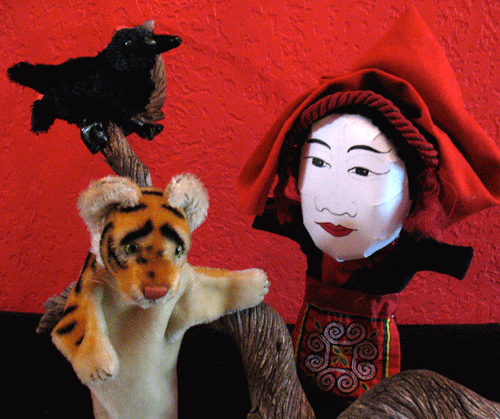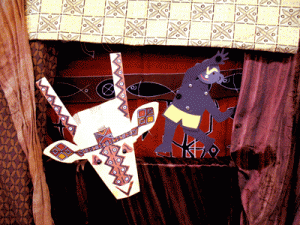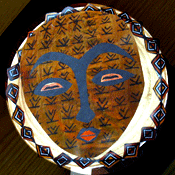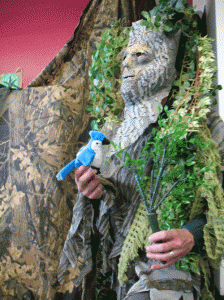 For my last Page Presents class of the season (as I prepare to be furloughed for at least three months), I chose the Hmong folktale, Nine-in-One, Grr! Grr!
For my last Page Presents class of the season (as I prepare to be furloughed for at least three months), I chose the Hmong folktale, Nine-in-One, Grr! Grr!
This is a delightful story, told by Blia Xiong and adapted by Cathy Spagnoli, with gorgeous illustrations by Nancy Horn based on Hmong embroidery.
Everyone admired my puppet, which was dressed somewhat authentically in an actual piece of Hmong embroidery, as well as a special mask Stuart that had created for it!
In the long ago time, when the Earth was much closer to the Sky, the First Tiger was very lonely because she and her mate did not yet have any cubs. Tiger brooded about this and decided to journey up to the Sky, to ask the great Shao how many cubs she would have.
Shao comes out to meet her.
“O, wise Shao,” she says, “I am so lonely. Will you please tell me how many cubs I will have?”
Shao thinks for a moment, and replies, “Nine each year.”
Tiger is overjoyed. But Shao cautions her that his prediction will only come true if she remembers his words.
As Tiger journeys back to her home, she begins to worry about her bad memory. What if she forgets Shao’s words? So she makes up a song:
As she goes along through the jungle singing her song, none of the animals pay any attention to her…except one. A big clever black bird wonders, “What does Tiger mean, singing this song and grinning to herself? I will go and ask the wise Shao!”
When Bird finds out what Tiger’s song means, he is dismayed and begs Shao to take back his words. But Shao refuses, saying only that his prediction holds only as long as Tiger remembers. This gives Bird an idea, and he flies swiftly back after Tiger.
Clever Bird tricks Tiger into forgetting her song. When she snarls at him for making her forget, he helpfully offers that he heard what she had been singing:
“One-in-nine, grr! grr!
One-in-nine, grr! grr!”
“Oh, that’s right,” says Tiger. “Now I remember, yes! Thank you!” And she continued singing:
“One-in-nine, grr! grr!
One-in-nine, grr! grr!”
And that is why there are not too many tigers in the world!
Here are a lot of Tiger cubs! Caitlyn, who has been coming for over a year but is always very shy and solemn, suddenly got in touch with her inner Tiger and hugely enjoyed scaring me with her ferocious roars! I love it when bashful kids shed their shyness and start participating fully in the fun. One of the mothers reported that her son has started making up his own puppet plays. She said he first announces the play, then goes off and rehearses it, and finally summons everyone to the performance!
{ 0 comments }











































